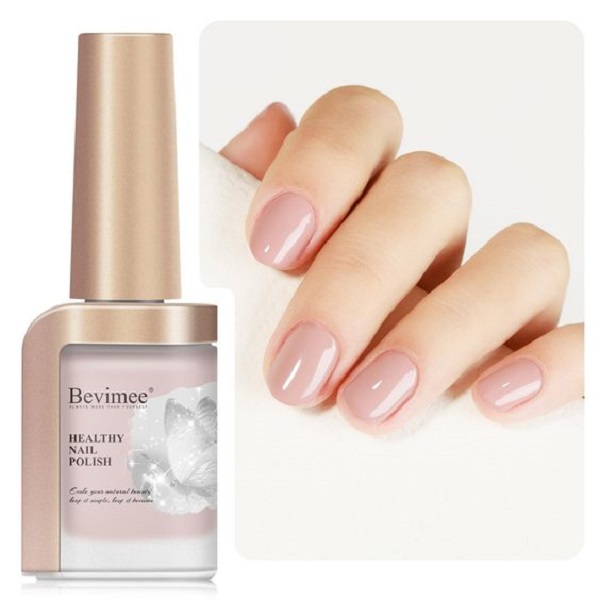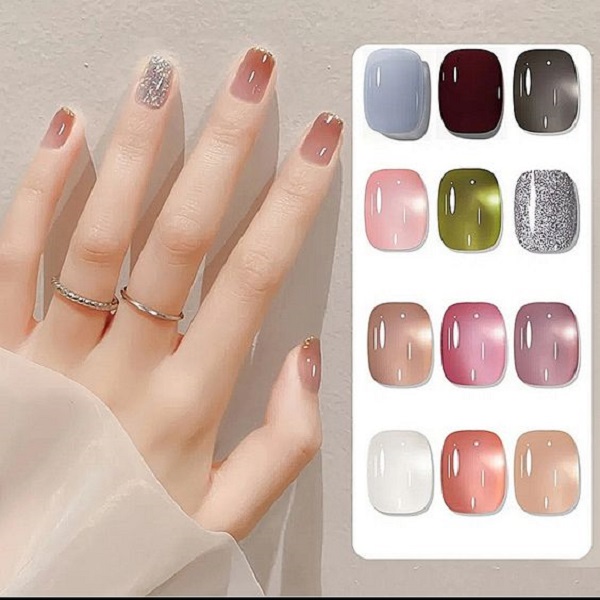Reasons Your Gel Polish Is Peeling Off Acrylics
It can be frustrating when your gel nail polish doesn’t stay put. Here are some common reasons why this might be happening to your acrylics.
Inadequate Nail Preparation
Good nail prep lays the foundation for long-lasting polish. Failing to prep nails correctly is a top reason for peeling. It’s crucial to clean and buff nails before applying polish to ensure a strong bond.
Insufficient Curing Under UV/LED Lights
If your gel polish is peeling, it might not have cured long enough. Gel polish requires a strict curing process under UV or LED lights. The recommended time is 30 to 60 seconds, but check polish instructions for the best results.
Too Smooth Nail Surface
While a smooth surface may seem ideal, it can cause polish to peel. Gel polish needs a slightly rough surface to cling to. Don’t buff your nails too much, or the polish won’t stick as well.
Presence of Moisture and Oils
Moisture and oils from your skin or products can prevent polish from adhering. Wash your hands without soap and skip the moisturizers before doing your nails. This ensures a clean surface for the gel to bond to.
Incorrect Polish Application Techniques
Applying your polish in thick layers or missing steps like the base coat can cause peeling. Use thin, even coats and do not skip any steps in your application process for the best durability.
By identifying these common pitfalls, you can adjust your nail routine for a more resilient gel manicure.
Common Causes of Gel Nail Polish Peeling
Experiencing peeling gel nail polish can be a letdown, especially when your fresh manicure starts chipping off your acrylics. Understanding the common causes of this peeling can help you take the right steps in your nail care routine to enhance the longevity of your gel manicure.
Applying Polish in Too Thick Layers
Thick layers of polish interfere with the curing process. Remember, thin coats are the key. Multiple thin layers ensure each coat cures evenly and adheres properly. Thick coatings often lead to premature peeling.
Using Expired Gel Polish
Old polish doesn’t stick well. Expired gel polish loses its effectiveness, affecting adhesion to nails. Always check the expiration date and consistency of your polish before application to avoid peeling.
Inadequate Curing Time for Gel Coats
Each polish layer needs ample curing time. Rushing through this step results in undercured polish that peels easily. Adhere to the recommended curing time for each layer to secure the bond between the polish and your acrylics.
Residue on the Nail Plate
Leftover oils and residues on nails make a weak foundation for polish. Prior to painting your nails, clean them thoroughly to remove any traces of oils or moisturizers, ensuring an optimal surface for polish application.
Capping the Free Edge of Nails
Protect the tips of your nails. Capping the free edge seals the polish, shielding it from daily wear that can cause peeling. This simple step can drastically improve the lifespan of your gel manicure. By steering clear of these common pitfalls, you’ll enhance the durability of your gel polish and enjoy a long-lasting, beautiful manicure.

Tips to Prevent Gel Nails from Peeling
Preventing peeling starts with proper techniques and good habits. Here’s how to keep gel polish intact.
Proper Removal of Old Gel Polish
Start with a clean slate. Fully remove old polish to help new gel adhere well.
Using a High-Quality Nail File
Use a good nail file for a rough surface. It helps polish bond to nails.
Drying Each Layer Completely
Don’t rush drying time. Fully dry each layer before applying the next for strong adhesion.
Sealing with a Top Coat
Seal in your hard work with a top coat. It prevents chipping and extends wear time.
Applying Thin and Even Layers
Thin, even layers of polish cure best. They’re less likely to peel than thick ones.
Maintaining Clean Nail Surfaces
Keep nails free of dust and oil. Clean them well before applying polish to prevent peeling.
How to Fix Peeling Gel Polish
Encountering gel polish peeling can be disheartening. But, there’s hope with these repair tips. Learn the steps to take when you notice a peel.
Filing and Buffing the Affected Area
Begin by smoothing out peels. A fine buffer can gently file the lifted edges. This preps the nail for more gel. Make sure not to file too hard to avoid nail damage.
Fresh Gel Application Over Peels
Once smooth, apply a new gel layer. Use a thin, even coat to cover peels. This can blend the old and new polish seamlessly. Remember to apply polish with care to avoid future lifting.
Proper Use of UV or LED Lamp for Curing
Curing is key for repair. Use your UV or LED lamp correctly for strong adhesion. Follow the lamp’s instructions exactly. This ensures the fresh gel cures and bonds well.
Cleaning Nails Post-Repair
After curing, clean up is next. Use a lint-free pad with alcohol to wipe nails. This removes any tacky layer left behind. It also helps prevent the introduction of new dust or oils.
By addressing the peeling issue with these methods, your gel polish can last longer. A gentle approach to filing, careful gel application, correct use of the curing lamp, and thorough post-repair cleaning are essential.

The Importance of Cuticle Health for Gel Polish Longevity
Cuticles play a big role in how long your gel polish lasts. Proper cuticle care stops polish from peeling prematurely.
Pushing Back and Maintaining Cuticles
Start with gently pushing back your cuticles. Use a cuticle pusher for this step. Then, trim any hangnails carefully with nipper. This gives a cleaner area for polish to stick onto. Next, smooth out the cuticle edge. A well-kept cuticle helps polish bond better and stay longer.
Hydration and Care for Cuticle Protection
Dry cuticles can lead to polish lifting. Keep them moisturized for healthy nails. Apply cuticle oil daily to nourish and protect. This prevents dryness and cracks. Well-hydrated cuticles support a firm polish grip. Plus, healthy cuticles make your manicure look sleek and professional.
By caring for cuticles, you help gel polish stay longer without peeling. This means fewer touch-ups and more time enjoying your perfect nails.
Health Considerations
In some instances, underlying health conditions or medications can affect your nail health and contribute to gel polish peeling.
- Hormonal changes: Hormonal fluctuations, such as those experienced during pregnancy or menopause, can affect nail strength and growth. Consequently, you may find that your gel manicures don’t last as long during these times.
- Medical conditions: Certain medical conditions, such as thyroid disorders or anemia, can also impact nail health. If you have any concerns, consult your doctor.
- Medications: Some medications can affect nail growth and strength. If you’re experiencing peeling and are taking any medications, talk to your doctor or pharmacist.

Maximizing Your Gel Manicure: Extra Tips for Success
Finally, here are a few extra tips to help you achieve long-lasting, peel-free gel manicures:
- Hydrate your nails: Keep your nails and cuticles hydrated by applying cuticle oil daily. This helps prevent dryness and brittleness, which can contribute to peeling.
- Give your nails a break: While gel manicures are durable, it’s important to give your nails a break between applications. This allows your nails to breathe and recover.
- Don’t forget the aftercare: Proper aftercare is crucial for maintaining your gel manicure. Avoid harsh chemicals, wear gloves when doing chores, and moisturize regularly.
- Seek professional help: If you’re consistently struggling with peeling gel polish, consider getting your manicures done by a professional nail technician. They have the expertise and tools to ensure proper application and curing.
By understanding the various factors that can contribute to gel polish peeling and taking the necessary precautions, you can enjoy beautiful, long-lasting manicures that will keep your nails looking their best.
